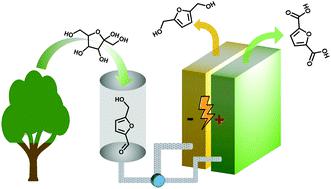当前位置:
X-MOL 学术
›
Green Chem.
›
论文详情
Our official English website, www.x-mol.net, welcomes your
feedback! (Note: you will need to create a separate account there.)
The production of valuable biopolymer precursors from fructose
Green Chemistry ( IF 9.3 ) Pub Date : 2020-09-11 , DOI: 10.1039/d0gc02315a Xuan Liu 1, 2, 3, 4 , Daniel Chee Yin Leong 1, 2, 3, 4 , Yujie Sun 1, 2, 3, 4
Green Chemistry ( IF 9.3 ) Pub Date : 2020-09-11 , DOI: 10.1039/d0gc02315a Xuan Liu 1, 2, 3, 4 , Daniel Chee Yin Leong 1, 2, 3, 4 , Yujie Sun 1, 2, 3, 4
Affiliation

|
The increasing demand for green chemical products calls for the exploration of sustainable and renewable carbon resources beyond fossil-based materials, whose utilization inevitably results in environmental concerns. As such, biomass valorisation has attracted increasing attention because biomass is the most widely available and sustainable carbon source. Among the available biomass-derived platform chemicals, 5-hydroxymethylfurfural (HMF) has long been regarded as an attractive candidate for the production of numerous value-added products. Nevertheless, the poor stability, and difficult separation and purification of HMF from fructose dehydration significantly inhibit its large-scale application. Herein, we report a two-step process for the direct production of two biopolymer precursors, 2,5-furandicarboxylic acid (FDCA) and 2,5-bis(hydroxymethyl)furan (BHMF), from fructose, bypassing the isolation of HMF. FDCA and BHMF are much easier to separate and purify from the reaction mixture than HMF, and they both can replace petroleum-based counterparts in the syntheses of many industrially important polymers, ranging from polyesters to polyamides. Optimized fructose dehydration under microwave irradiation achieved a high HMF yield (83%) using a biphasic strategy. The subsequent electrocatalytic conversion of the resulting microwave reaction mixture allowed us to carry out either oxidation or reduction via readily tuning the electrochemical parameters to yield FDCA or BHMF, respectively. The integration of microwave irradiation and electrocatalysis in a flow electrolyzer enabled the direct conversion of readily available fructose to highly valuable FDCA and BHMF without the expensive and challenging step of HMF isolation, suggesting an economically attractive approach for upgrading carbohydrates.
中文翻译:

用果糖生产有价值的生物聚合物前体
对绿色化学产品的需求不断增长,这就要求探索基于化石的材料以外的可持续和可再生碳资源,而其利用不可避免地会引起环境问题。因此,由于生物质是最广泛获得和可持续的碳源,因此生物质增值引起了越来越多的关注。在可获得的生物质衍生的平台化学品中,长期以来,人们一直将5-羟甲基糠醛(HMF)视为生产众多增值产品的诱人候选人。然而,果糖脱水的稳定性差,以及难以从果糖脱水中分离和纯化HMF明显抑制了其大规模应用。本文中,我们报告了直接生产两种生物聚合物前体2,5,5-呋喃二甲酸(FDCA)和2的分两步流程 来自果糖的5-双(羟甲基)呋喃(BHMF),绕过了HMF的分离。FDCA和BHMF比HMF更容易从反应混合物中分离和纯化,并且它们都可以代替许多工业上重要的聚合物(从聚酯到聚酰胺)的合成中石油基的对应物。使用双相策略,在微波辐射下优化的果糖脱水可实现高HMF收率(83%)。所得微波反应混合物的后续电催化转化使我们能够进行氧化或还原 从聚酯到聚酰胺。使用双相策略,在微波辐射下优化的果糖脱水可实现高HMF收率(83%)。所得微波反应混合物的后续电催化转化使我们能够进行氧化或还原 从聚酯到聚酰胺。使用双相策略,在微波辐射下优化的果糖脱水可实现高HMF收率(83%)。所得微波反应混合物的后续电催化转化使我们能够进行氧化或还原通过容易地调节电化学参数分别产生FDCA或BHMF。流式电解槽中微波辐照和电催化的集成,使易得的果糖直接转化为高价值的FDCA和BHMF,而无需进行昂贵且富挑战性的HMF分离步骤,这表明在经济上具有吸引力的方法可用于升级碳水化合物。
更新日期:2020-10-05
中文翻译:

用果糖生产有价值的生物聚合物前体
对绿色化学产品的需求不断增长,这就要求探索基于化石的材料以外的可持续和可再生碳资源,而其利用不可避免地会引起环境问题。因此,由于生物质是最广泛获得和可持续的碳源,因此生物质增值引起了越来越多的关注。在可获得的生物质衍生的平台化学品中,长期以来,人们一直将5-羟甲基糠醛(HMF)视为生产众多增值产品的诱人候选人。然而,果糖脱水的稳定性差,以及难以从果糖脱水中分离和纯化HMF明显抑制了其大规模应用。本文中,我们报告了直接生产两种生物聚合物前体2,5,5-呋喃二甲酸(FDCA)和2的分两步流程 来自果糖的5-双(羟甲基)呋喃(BHMF),绕过了HMF的分离。FDCA和BHMF比HMF更容易从反应混合物中分离和纯化,并且它们都可以代替许多工业上重要的聚合物(从聚酯到聚酰胺)的合成中石油基的对应物。使用双相策略,在微波辐射下优化的果糖脱水可实现高HMF收率(83%)。所得微波反应混合物的后续电催化转化使我们能够进行氧化或还原 从聚酯到聚酰胺。使用双相策略,在微波辐射下优化的果糖脱水可实现高HMF收率(83%)。所得微波反应混合物的后续电催化转化使我们能够进行氧化或还原 从聚酯到聚酰胺。使用双相策略,在微波辐射下优化的果糖脱水可实现高HMF收率(83%)。所得微波反应混合物的后续电催化转化使我们能够进行氧化或还原通过容易地调节电化学参数分别产生FDCA或BHMF。流式电解槽中微波辐照和电催化的集成,使易得的果糖直接转化为高价值的FDCA和BHMF,而无需进行昂贵且富挑战性的HMF分离步骤,这表明在经济上具有吸引力的方法可用于升级碳水化合物。











































 京公网安备 11010802027423号
京公网安备 11010802027423号